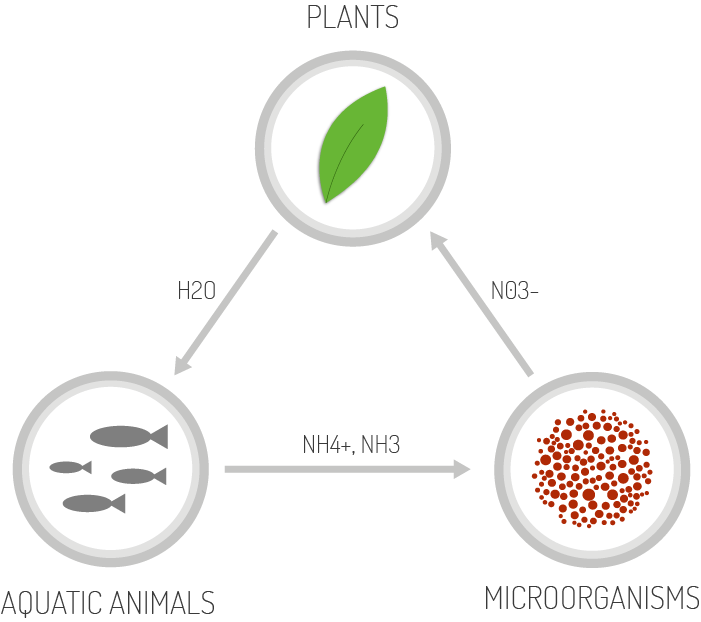An aquaponic system is an artifcial ecosystem that attempts to mimic part of natures metabolic cycle. Through the combination of a set of carefully selected organisms the system becomes nearly self-contained. Generally there are three diffrent kinds of living creatures in an aquaponics system, animals, micro-organisms and plants.

The waste of the animals gets dissolved in water and is then filtered mechanically through the grow media. Microorganisms living inside the grow bed, initiate
a process called nitrification where ammonia and ammonium gets transformed to nitrite and
then nitrite is processed to nitrate.
The plants in return rid the water of the
nitrate using it for their own metabolism. Afterwards the water is cleared of all
toxic substances and can be reused to provide a healthy environment for the aquatic animals
to live in.
All nutrients your plants need will either be produced by the organisms inside the habitat or added through fish feed. Everything you are growing is 100 percent organic.
Due to the closed nature of the system there is almost no water loss. In comparison to state of the art agricultural production methods, aquaponics only uses 10 percent of the water that is normally used.
There is enough nutrients for everybody! Your plants won't have to fight for them, resulting in shorter grow cycles and reduced spacial needs for your leafy friends.
Plants are autotrophic organisms, their wellbeing depends on diffrent factors.
For the generation of sugar and starch through photosynthesis light is essential.
Plants also need water and a set of micro and macro nutrients. Other factors
influencing the efficiency of the plants include atmospheric temperature and humidity,
the amount of carbon dioxide, temperature, humidity inside the growing
media and the amount of oxygen accessible to the roots.
There is almost no
limitation to the kind of plants that can be grown in an aquaponic system. The
only limiting factor is the pH-value. Because the animals and microorganisms
are highly dependent on the right pH-level of the water running through the
system. The range of the pH can vary from around 6 up to 7.5 depending on
the organisms being deployed and on how well the system is cycled. As a consequence
you wouldn't be able to grow plants dependent on acid or alkaline soils
such as blueberries.
All of the nutrients are available and ready to use in an
aquaponic system. Because of the constant provision of water in an aquaponic
system, it is highly suitable for plants with high water demands. All kinds of
salads, mints and tomatoes will be happy in an aquaponic system. Even fruits
like Mangos, Avocados and even Pineapples can be cultivated in aquaponic
systems, regardless of the geographic location.
There are two specific microorganisms that are involved in a process called
nitrification. Nitrosomonas sp. use up the ammonium, created by the animals
waste, for their metabolism and in return produce nitrite. Nitrite, then gets
broken down to nitrate by nitrobacter sp. These organisms thrive well in high
oxygenated water with a temperature between 14 and 30 degree Celsius. They
hold on to porous material like hydro-ton or volcanic rocks. It is important that
these bacteria never dry out, this would be fatal within a few hours.
Without the help of nitrifying bacteria aquatic organisms wouldn't be able to survive
in the system. Ammonium is toxic in relatively small doses. Even though
the tolerance of aquatic animals for nitrate is higher than for ammonium, without plants
reducing the amount of nitrate critical levels a reached very fast.
Nitrosomonas
will spawn and grow on their own as soon as there is ammonium in the system.
After some of the ammonium is converted, nitrobacter will start to grow. The
size of the population of the two microorganisms will vary since it depends on
the amount of soluted substances, dissolved oxygen levels and temperature of the water.
In theory an artificial ecosystem can be established with any species of animal.
In cycle-crop chicken, goats or cows are often used. In an aquaponic system, fresh water aquatic
animals are used. They only require a little amount of space and their habitat can be controlled fairly easy.
The exact species is best chosen in regard of the systems site. For temperate
climate, species like Tilapia and perches are ideal since they don't depend on
high water temperatures, minimizing the energy consumption of the system.
In arid or tropical zones warm water fish would be ideal. Some setups even
support shrimp or lobster cultivation.
Carnivores, depending on nutrition by animal tissue,
are rather inefficient to use, since they require the use of external feed or the
integration of another species into the system that serves as a food source.
Vermicomposts can be used to grow worms rather easy and cheap from crop
waste. The use of herbivores is probably best since the feed can be grown
hydroponically.
Aquatic animals depend on clean, well temperated water in the
right pH-range. Additionally the water needs to hold an adequate amount of
dissolved oxygen. One factor to consider is that the usage of tab water can
in some areas be rather difficult. Tab water is often sterilized by the help of
chlorine. Even in small amounts, chlorine will harm any organism inside your system.
It is best to hydrate tab-water for a few days before adding it to the system, ensuring
the decomposition of the chlorine and raising the amount of dissolved oxygen.